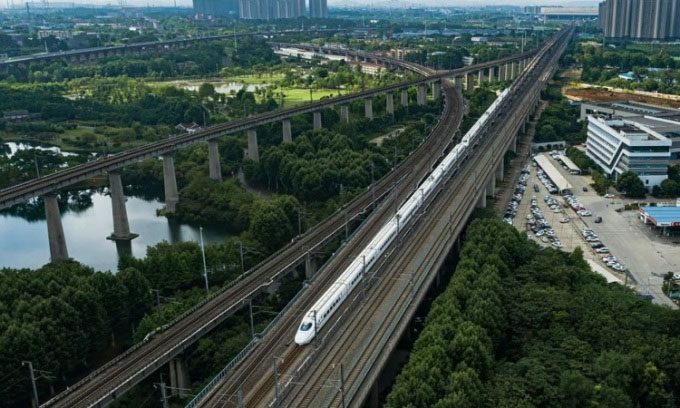Chinese engineers are utilizing artificial intelligence-equipped construction robots to develop railways at an unprecedented speed.
The world’s largest high-speed rail network in China is set to expand even further. By the end of this year, several new lines will join the massive electrified railway system of the country, including the Fuzhou – Xiamen line (277 km), the Guangzhou – Shanwei line (203 km), and the Shanghai – Nanjing line (278 km). Once operational, the total length of these new railway lines will be more than double the entire length of Germany’s high-speed rail network, with each line featuring trains capable of reaching maximum operational speeds of 350 km/h, according to SCMP.

A high-speed train running near Wuhan. (Photo: Xinhua).
However, the latest railway lines differ from most existing railways in that they are being constructed by specially designed robots. This automated construction method has been tested and approved for use in upcoming high-speed rail projects, according to Wang Peixiong, chief engineer of the China Electric Railway Construction Group. The deployment of electrified railway construction robots on a large scale marks a significant milestone in the industry, demonstrating that machinery can take on much of the labor-intensive work, including high-speed railway construction.
Railway construction involves numerous tasks such as excavation, grading, laying tracks, building bridges and tunnels, and installing signaling and communication systems. This is an expensive infrastructure endeavor that requires a large amount of manual labor as well as skilled and knowledgeable experts. In the past, railway projects were very dangerous undertakings. For example, the railway through the Sierra Nevada mountains in the United States required over 10,000 construction workers.
Nowadays, robots and various advanced technologies are responsible for much of the labor-intensive work in railway construction. For instance, in 2018, China introduced an automated machine capable of laying high-speed tracks at a speed of 1.5 km per day. By 2021, improved precision and the ability to work 24/7 allowed automated railway construction machines to install 2 km of tracks in a single day. Soon after, robots expanded their capabilities beyond track laying. Welding, painting, and inspections can now be performed by robots. Automated equipment can also dig tunnels and pour concrete, among other tasks.
However, it was only recently that robots were able to construct elevated electrification structures for high-speed railways. This task was previously considered too complex for machines, according to Wang and his colleagues. The electrical wiring structures, supporting frameworks, masts, and pantographs that provide power to the trains are known as the Overhead Contact System (OCS). Constructing the OCS network for high-speed railways involves complex processes such as pre-assembling the pantographs and suspension cables, transporting materials to the construction site, and installing the supporting frameworks and masts.
Installing the supporting frameworks and suspension cables is particularly dangerous work, requiring operation at great heights under pressure. For example, attaching the pantograph of the overhead contact system to the supporting mast requires workers to attach a pulley to the top of the mast, then use a rope tied to the pantograph on the ground to pull it up, according to Jiang Zhehua, an engineer in Wang’s team.
This process requires several workers on the ground to coordinate with those on the supporting mast. If an accident occurs, the work can be fatal. Due to the risks and the nature of the work, assembling the OCS network has become the most labor-intensive part of the high-speed railway project.
To address this issue, railway engineers have developed automated construction technology that utilizes a digital data management platform and smart systems to store, pre-assemble, transport, and construct. Automated sensors collect real-time data from the construction site and send it to a smart warehouse, where the automated storage and retrieval system identifies and delivers the necessary materials to the assembly plant for the supporting frameworks, pantographs, hanging rods, and many other components, which are then lifted and placed in the appropriate positions.
However, robots also face challenges when constructing the OCS, according to the engineering team. One of the most complex aspects of the job involves a large amount of cables, supporting masts, pantographs, and many components that need to be installed accurately and synchronously. The construction site also presents numerous challenges such as uneven terrain, natural obstacles, adverse weather, and other factors that can hinder the installation process. Robots may struggle to navigate obstacles or adjust to changes in the environment. The OCS installation process also requires a coordinated array of robots working smoothly together to complete the task.
The solution to these challenges is artificial intelligence. Scientists allow the robots installed at the construction site to use image recognition algorithms and feature extraction of targets to plan the optimal process for installing pantographs with precision within a range of 1 mm. AI also enables robots to work in various adverse weather conditions and operate alongside each other. With AI support, robots become more flexible, capable of moving between workstations, adjusting and tightening screws, and then returning to a waypoint to await further instructions.
In the warehouse, AI-powered equipment like smart forklifts can lift and transport materials, according to Gao Qi, an engineer in Wang’s team. These intelligent machines are programmed for self-maintenance and can operate 24 hours a day, performing a range of tasks with high precision. The quality control functions of the warehouse have also improved. Stored materials are categorized and transported through a dark room for scanning. A specialized neural network model trained on 30 different types of materials can detect defects in materials before use. This technology enhances warehouse efficiency, making the processing speed 10 times faster than traditional warehouses.
While robots can work all day without rest and without affecting accuracy, they can also play a crucial role in areas lacking skilled labor or where labor costs are prohibitively high.


















































